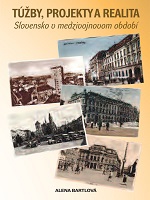Túžby, projekty a realita. Slovensko v medzivojnovom období
Needs, projects and reality. Slovakia in the inter-war period
Author(s): Alena Bartlová
Contributor(s): Jozef Hupka (Editor), Július Bartl (Editor)
Subject(s): History, Diplomatic history, Economic history, Political history, Recent History (1900 till today), Interwar Period (1920 - 1939)
Published by: SAV - Slovenská akadémia vied - Historický ústav SAV
Keywords: Slovakia; Czechoslovakia; interwar; needs; projects; reality; political history; autonomy; economic history; Milan Hodža; Štefan Janšák; Jozef Tiso; Jozef Cieker;
Summary/Abstract: The monograph consists of 15 studies and articles published by the author in a number of periodicals in the period of her over forty years’ career in the Slovak Academy of Sciences Historical Institute. Describing the important events, efforts, needs and programs of the Slovak people in interwar Czechoslovakia, the author divides the studies into three parts: dealing with the political history of Slovakia in part one, focusing on the significant economic issues in part two, and following the fate of notable individuals involved in public and social affairs in part three. In addition, the development related with Martin, the town of great importance also for the interwar period, is closely surveyed; finally the author gives some thoughts to the impact of dramatic art on the cultural advancement of Slovakia. The author commences with the question in what extent the general public of the Slovaks and Czechs was ready to constitute a common state, concluding that both the Czech and the Slovak political leaders had aspirations concerning disintegration of Austria-Hungary which was considered a real impediment of the development and progress of the two nations. In the last months of the world war the Slovak political representatives, making every effort to get emancipated from Hungary, formed a joint representative body, the Slovak National Council, and later - with a substantial Czech assistance – they started to build the foundations of the new administrative, educational and judicial systems. New political parties, attracting fresh supporters, appeared with various programs, taking into consideration the actual gloomy social situation of the majority of the Slovak population living in poverty with little or no national awareness and political experience. The situation in the Czech part of the state was quite different. The Czech political and economic representatives, having built - over the decades - a full structure of the national educational system (from elementary schools to universities), a network of effective political parties represented by tenths of members in the Vienna Imperial Parliament, could rely on the support of thousands nationally conscious, politically organized and economically prosperous citizens. The differences between the Slovak and Czech society during the months of the preparation for, and during, the political coup d’etat 1918 resulted also in the relationship of the two nations, determining their status, desires, programs, as well as the actualities of everyday life in the whole period of twenty years between the world wars. At the end of the twenties and the beginning of the thirties years there was a new generation of public offi cers brought up by the democratic educational system and political representation, who realized that any outstanding, strictly formulated projects of inevitable changes in the social and economic system would be just hollow aspirations similar to the those expressed in the Petition to the Emperor in the 19th century, unless the people of Slovakia gained adequate share in the political power. For the first step into the road to succeed in winning such position it was necessary to unite the political forces. The first signal of entering the course to this goal was the establishment of the National Economy Institute of Slovakia proposed by M. Hodža and supported by all the political parties, even the governmental authorities. A number of important activities were organized, among them several signifi cant attempts to unite the political parties, e.g. the Meeting of Young Intelligence held in Trenčianske Teplice in 1932, and other events. Seemingly, these actions could have been provoked by the world economic crisis and its ruthless consequences. However, the crisis just revealed serious dragging problems of Slovakia left behind unattended for years by the government. Quite naturally, this was a good fuel for a successful drive of anti-governmental opposition parties taking advantage of the situation and aiming to seize the power to carry out their own programs. In addition, the international situation in 1938, supportive of fundamental changes in the political system in Czechoslovakia, made it possible for a section of the opposition to spin the wheel of fate of the Slovak people. Under unusually dramatic circumstances, a great opportunity opened up for the incoming generation that tried to apply the knowledge and skills accumulated in the course of twenty years of the political, economic, and cultural struggle in the Pre-Munich Czechoslovakia. The second part of the monograph includes some results of the author’s study of the Slovak economic history with primary focus on food processing, and incidental problems related with the world economic crisis striking Slovak economy in 1929-1934 with some sectors suffering until 1938. In the last part the author describes the history of three well known figures of different professional or political affiliation: Ing. Štefan Janšák, a high official active in several economic sectors, with the authority to affect economic development of Slovakia, the catholic priest Dr. Jozef Tiso, a leader of Hlinka´s Slovak People’s Party, and Dr. Jozef Cieker holding office in the Czechoslovak Foreign Department and serving as the ambassador of Slovakia in different European countries after 1939. Ultimately, the author brings two studies, one concerning the history of the city of Martin in 1918-1938, and the other dealing with the activities of the professional Slovak National Theatre in Bratislava and some unprofessional dramatic ensembles and their impact on the interwar cultural and social advancement of Slovakia.
- Print-ISBN-13: 978-80-89396-06-1
- Page Count: 262
- Publication Year: 2010
- Language: Slovak
- eBook-PDF
- Sample-PDF
- Introduction
- Table of Content

